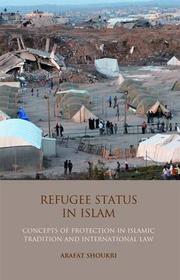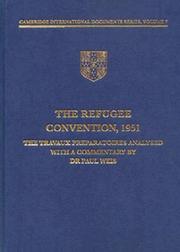| Listing 1 - 10 of 27 | << page >> |
Sort by
|

ISBN: 9781848853904 1848853904 Year: 2011 Publisher: London ; New York : I. B. Tauris,
Abstract | Keywords | Export | Availability | Bookmark
 Loading...
Loading...Choose an application
- Reference Manager
- EndNote
- RefWorks (Direct export to RefWorks)
Book
Year: 2011 Publisher: Oxford : Oxford University Press,
Abstract | Keywords | Export | Availability | Bookmark
 Loading...
Loading...Choose an application
- Reference Manager
- EndNote
- RefWorks (Direct export to RefWorks)
The 1951 Refugee Convention and its 1967 Protocol are the cornerstones of international refugee law. This commentary provides a systematic, article-by-article analysis of their provisions and thematic chapters examine general issues in refugee law.
Book
ISBN: 0191994065 0198885717 0198885709 Year: 2024 Publisher: Oxford : Oxford University Press,
Abstract | Keywords | Export | Availability | Bookmark
 Loading...
Loading...Choose an application
- Reference Manager
- EndNote
- RefWorks (Direct export to RefWorks)
In the first dedicated monograph on article 16 of the 1951 Refugee Convention, Emma Dunlop positions the article within the broader context of public international law, presenting a comprehensive account of asylum seekers' and refugees' right of access to courts.
Refugees --- Due process of law. --- Law. --- International law. --- Legal status, laws, etc. --- Convention Relating to the Status of Refugees
Book
Year: 1991 Volume: v.3, nr.3 (1991) Publisher: Oxford : Oxford University Press,
Abstract | Keywords | Export | Availability | Bookmark
 Loading...
Loading...Choose an application
- Reference Manager
- EndNote
- RefWorks (Direct export to RefWorks)
Refugees --- Réfugiés --- Legal status, laws, etc. --- Congresses. --- Droit --- Congrès --- Convention Relating to the Status of Refugees --- Convention relative au statut des réfugiés
Book
ISBN: 9780192855114 0192855115 Year: 2024 Publisher: Oxford: New York: Oxford University Press,
Abstract | Keywords | Export | Availability | Bookmark
 Loading...
Loading...Choose an application
- Reference Manager
- EndNote
- RefWorks (Direct export to RefWorks)
When the drafters of the 1951 Convention first considered the rights and status of refugees, they were able to draw on a legal tradition that had developed in the interwar years, beginning with the 1922 'Nansen passport' for Russian refugees and including the 1933 Convention. This legal foundation was not the result of a comprehensive approach to refugee issues but rather represented an ad hoc method of defining key principles; these principles, namely that refugees were a distinct category of migrants deserving special attention and help, and that refugees should not be sent back to a country of persecution, would later be incorporated into the 1951 Convention. In addition, the experience of refugees in the interwar years evidenced how their right to work and ability to achieve self-reliance was in many cases premised on their right to travel internationally. Moreover, institutional arrangements forged a link between refugee law and international organizations, a connection that would be solidified by the drafting of the 1951 Convention and the creation of the UNHCR. The Convention Relating to the Status of Refugees adopted on 28 July 1951 in Geneva continues to provide the most comprehensive codification of the rights of refugees yet attempted. Consolidating previous international instruments relating to refugees, the 1951 Convention with its 1967 Protocol marks a cornerstone in the development of international refugee law. At present, there are 149 States Parties to one or both of these instruments, expressing a worldwide consensus on the definition of the term refugee and the fundamental rights to be granted to refugees. These facts demonstrate and underline the extraordinary significance of these instruments as the indispensable legal basis of international refugee law.This Commentary provides for a systematic and comprehensive analysis of the 1951 Convention and the 1967 Protocol on an article-by-article basis, exposing the interrelationship between the different articles and discussing the latest developments in international refugee law. In addition, several thematic contributions analyse questions of international refugee law which are of general significance, such as regional developments, the interrelationship between refugee law and general human rights law, as well as the relationship between refugee law and the law of the sea.
Refugees --- International law. --- Réfugiés --- Droit international. --- Legal status, laws, etc. --- Statut juridique. --- Nations Unies --- Convention Relating to the Status of Refugees
Book
ISSN: 22133836 ISBN: 9789004273696 9004273697 9004295992 9789004295995 Year: 2020 Volume: 17 Publisher: Leiden;Boston Brill | Nijhoff
Abstract | Keywords | Export | Availability | Bookmark
 Loading...
Loading...Choose an application
- Reference Manager
- EndNote
- RefWorks (Direct export to RefWorks)
"Terrorism and Asylum, edited by James C. Simeon, explores terrorism and asylum in all its interrelated and variable aspects, and permutations. The critical role terrorism plays as a driver in forced displacement, within the context of protracted armed conflict and extreme political violence, is analyzed. Exclusion from refugee protection for the alleged commission of terrorist activities is thoroughly interrogated. Populist politicians' blatant use of the "fear of terrorism" to further their public policy security agenda and to limit access to refugee protection is scrutinized. The principal issues and concerns regarding terrorism and asylum and how these might be addressed, in the public interest while, at the same time, protecting and advancing the human rights and dignity of everyone are offered"
Refugees --- Political refugees --- Asylum, Right of. --- Freedom of movement (International law) --- Terrorism (International law) --- Terrorism --- Legal status, laws, etc. --- Prevention --- Law and legislation --- Convention Relating to the Status of Refugees --- Asylum, Right of --- Refugees - Legal status, laws, etc. --- Political refugees - Legal status, laws, etc. --- Terrorism - Prevention - Law and legislation --- Convention Relating to the Status of Refugees (1951 July 28)

ISBN: 0521472954 Year: 1995 Volume: 7 Publisher: Cambridge Cambridge University Press
Abstract | Keywords | Export | Availability | Bookmark
 Loading...
Loading...Choose an application
- Reference Manager
- EndNote
- RefWorks (Direct export to RefWorks)
Book
ISBN: 9781108747127 9781108478229 9781108784580 Year: 2020 Publisher: Cambridge Cambridge University Press
Abstract | Keywords | Export | Availability | Bookmark
 Loading...
Loading...Choose an application
- Reference Manager
- EndNote
- RefWorks (Direct export to RefWorks)
"This book is concerned with refugee status determination in the context of 'natural' disasters and climate change. Considering evidence that the legal predicament of people who seek recognition of refugee status in this connection has been inconsistently addressed by judicial bodies in leading refugee law jurisdictions, and identifying epistemological as well as doctrinal impediments to a clear and principled application of international refugee law in this connection, the book develops a methodlogy that is theoretically informed by decades of scholarship in disaster risk reduction and doctrinally guided by a human rights-based approach. When disasters are understood as purely reflecting the indiscriminate forces of nature, it is difficult to imagine how a person may establish a well-founded fear of being persecuted, as required by Article 1A(2) of the Refugee Convention. However, when disasters are understood as the consequence of natural hazards interacting with exposed and vulnerable social conditions, the kinds of circumstances in which a person may establish eligibility for recognition of refugee status become much clearer. However, applying the dominant human rights-based approach in the context of disasters and climate change reveals deeply rooted assumptions about the meaning of core elements of the refugee definition, and a recalibrated human rights-based interpretation of general application as developed"--
Refugees --- Asylum, Right of. --- Environmental refugees --- Disaster victims --- Legal status, laws, etc. --- Convention Relating to the Status of Refugees --- Réfugiés --- Droit d'asile --- Réfugiés écologiques --- Victimes de catastrophes --- Droit
Book
ISBN: 9780367528256 9780367893507 9781003018728 Year: 2021 Publisher: London Routledge, Taylor & Francis Group
Abstract | Keywords | Export | Availability | Bookmark
 Loading...
Loading...Choose an application
- Reference Manager
- EndNote
- RefWorks (Direct export to RefWorks)
Asylum, Right of. --- Political persecution. --- Political refugees --- Sex discrimination against women --- Women refugees --- Women --- Legal status, laws, etc. --- Law and legislation. --- Crimes against. --- Convention Relating to the Status of Refugees --- Migration. Refugees --- Comparative law --- International private law --- Human rights
Book
ISBN: 1108784585 1108787770 110878755X 1108478220 1108747124 Year: 2020 Publisher: Cambridge : Cambridge University Press,
Abstract | Keywords | Export | Availability | Bookmark
 Loading...
Loading...Choose an application
- Reference Manager
- EndNote
- RefWorks (Direct export to RefWorks)
Climate Change, Disasters and the Refugee Convention is concerned with refugee status determination (RSD) in the context of disasters and climate change. It demonstrates that the legal predicament of people who seek refugee status in this connection has been inconsistently addressed by judicial bodies in leading refugee law jurisdictions, and identifies epistemological as well as doctrinal impediments to a clear and principled application of international refugee law. Arguing that RSD cannot safely be performed without a clear understanding of the relationship between natural hazards and human agency, the book draws insights from disaster anthropology and political ecology that see discrimination as a contributory cause of people's differential exposure and vulnerability to disaster-related harm. This theoretical framework, combined with insights derived from the review of existing doctrinal and judicial approaches, prompts a critical revision of the dominant human rights-based approach to the refugee definition.
Convention Relating to the Status of Refugees (1951 July 28) --- Refugees --- Asylum, Right of. --- Environmental refugees --- Disaster victms --- Legal status, laws, etc. --- Convention Relating to the Status of Refugees --- Environmental migrants --- Environmentally displaced persons --- Asylum, Right of --- Right of asylum --- Sanctuary (Law) --- Defection --- Deportation --- Extradition --- Law and legislation --- Da Panāh Ghūṣhtūnko da Waz̤ʻe pah Aṛah Muqāwalah (Kunwānsiyūn) --- Konvensi Mengenai Kedudukan Pengungsi --- Kunvānsiyūn-i 1951 dar Umūr-i Panāhindahʹgān --- Refugee Convention --- United Nations Refugee Convention --- Disaster victims --- Victims of disasters --- Victims
| Listing 1 - 10 of 27 | << page >> |
Sort by
|

 Search
Search Feedback
Feedback About UniCat
About UniCat  Help
Help News
News